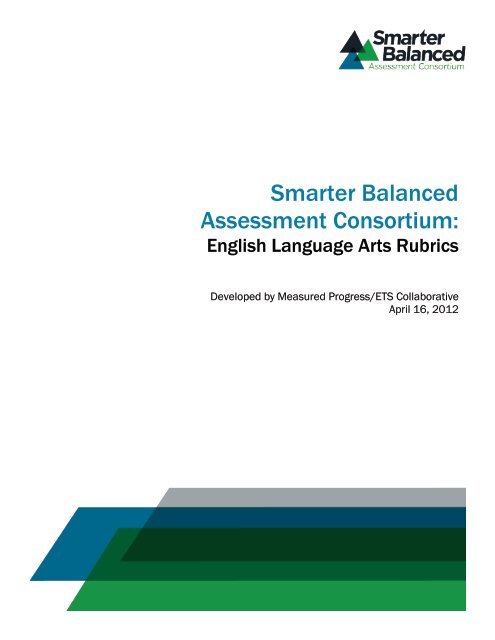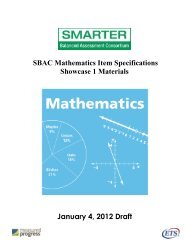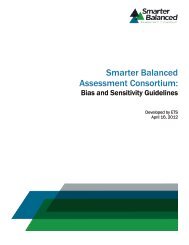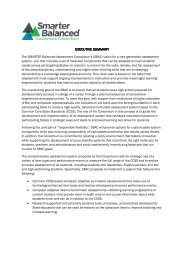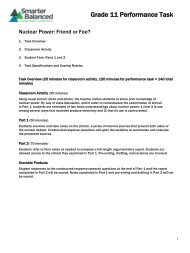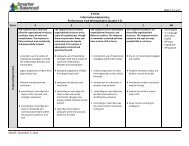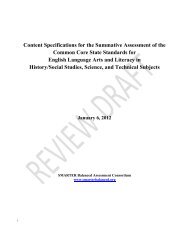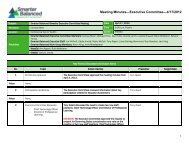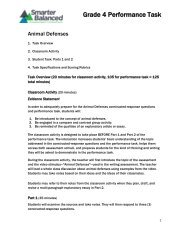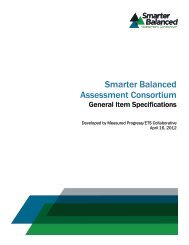ELA Rubrics - Smarter Balanced Assessment Consortium
ELA Rubrics - Smarter Balanced Assessment Consortium
ELA Rubrics - Smarter Balanced Assessment Consortium
Create successful ePaper yourself
Turn your PDF publications into a flip-book with our unique Google optimized e-Paper software.
<strong>Smarter</strong> <strong>Balanced</strong><br />
<strong>Assessment</strong> <strong>Consortium</strong>:<br />
English Language Arts <strong>Rubrics</strong><br />
Developed by Measured Progress/ETS Collaborative<br />
April 16, 2012
<strong>Smarter</strong> <strong>Balanced</strong><br />
Argumentative Writing Rubric (Grades 6–11)<br />
Sample Generic 4-point Argumentative Writing Rubric (Grades 6-11)<br />
Score<br />
Statement of Purpose/Focus and Organization<br />
Statement of<br />
Purpose/Focus<br />
Development: Language and Elaboration of Evidence<br />
Organization Elaboration of Evidence Language and Vocabulary<br />
Conventions<br />
4<br />
The response is fully<br />
sustained and<br />
consistently and<br />
purposefully focused:<br />
claim is clearly stated,<br />
focused and strongly<br />
maintained<br />
alternate or opposing<br />
claims are clearly<br />
addressed*<br />
claim is introduced<br />
and communicated<br />
clearly within the<br />
context<br />
The response has a clear<br />
and effective<br />
organizational structure<br />
creating unity and<br />
completeness:<br />
effective, consistent<br />
use of a variety of<br />
transitional strategies<br />
logical progression of<br />
ideas from beginning<br />
to end<br />
effective introduction<br />
and conclusion for<br />
audience and purpose<br />
strong connections<br />
among ideas, with<br />
some syntactic variety<br />
The response provides<br />
thorough and convincing<br />
support/evidence for the<br />
writer’s claim that<br />
includes the effective use<br />
of sources, facts, and<br />
details. The response<br />
achieves substantial<br />
depth that is specific and<br />
relevant:<br />
use of evidence from<br />
sources is smoothly<br />
integrated,<br />
comprehensive,<br />
relevant, and concrete<br />
effective use of a<br />
variety of elaborative<br />
techniques<br />
The response clearly and<br />
effectively expresses<br />
ideas, using precise<br />
language:<br />
use of academic and<br />
domain-specific<br />
vocabulary is clearly<br />
appropriate for the<br />
audience and purpose<br />
The response<br />
demonstrates a strong<br />
command of conventions:<br />
few, if any, errors are<br />
present in usage and<br />
sentence formation<br />
effective and consistent<br />
use of punctuation,<br />
capitalization, and<br />
spelling<br />
<strong>Smarter</strong> <strong>Balanced</strong> Argumentative Writing Rubric (Grades 6–11) 1
<strong>Smarter</strong> <strong>Balanced</strong><br />
Argumentative Writing Rubric (Grades 6–11)<br />
Sample Generic 4-point Argumentative Writing Rubric (Grades 6-11)<br />
Score<br />
Statement of Purpose/Focus and Organization<br />
Statement of<br />
Purpose/Focus<br />
Development: Language and Elaboration of Evidence<br />
Organization Elaboration of Evidence Language and Vocabulary<br />
Conventions<br />
3<br />
The response is<br />
adequately sustained<br />
and generally focused:<br />
claim is clear and for<br />
the most part<br />
maintained, though<br />
some loosely related<br />
material may be<br />
present<br />
context provided for<br />
the claim is adequate<br />
The response has an<br />
evident organizational<br />
structure and a sense of<br />
completeness, though<br />
there may be minor flaws<br />
and some ideas may be<br />
loosely connected:<br />
adequate use of<br />
transitional strategies<br />
with some variety<br />
adequate progression<br />
of ideas from<br />
beginning to end<br />
adequate introduction<br />
and conclusion<br />
adequate, if slightly<br />
inconsistent,<br />
connection among<br />
ideas<br />
The response provides<br />
adequate<br />
support/evidence for<br />
writer’s claim that<br />
includes the use of<br />
sources, facts, and<br />
details. The response<br />
achieves some depth and<br />
specificity but is<br />
predominantly general:<br />
some evidence from<br />
sources is integrated,<br />
though citations may<br />
be general or<br />
imprecise<br />
adequate use of some<br />
elaborative techniques<br />
The response adequately<br />
expresses ideas,<br />
employing a mix of<br />
precise with more general<br />
language<br />
use of domain-specific<br />
vocabulary is generally<br />
appropriate for the<br />
audience and purpose<br />
The response<br />
demonstrates an adequate<br />
command of conventions:<br />
some errors in usage<br />
and sentence formation<br />
may be present, but no<br />
systematic pattern of<br />
errors is displayed<br />
adequate use of<br />
punctuation,<br />
capitalization, and<br />
spelling<br />
<strong>Smarter</strong> <strong>Balanced</strong> Argumentative Writing Rubric (Grades 6–11) 2
<strong>Smarter</strong> <strong>Balanced</strong><br />
Argumentative Writing Rubric (Grades 6–11)<br />
Sample Generic 4-point Argumentative Writing Rubric (Grades 6-11)<br />
Score<br />
Statement of Purpose/Focus and Organization<br />
Statement of<br />
Purpose/Focus<br />
Development: Language and Elaboration of Evidence<br />
Organization Elaboration of Evidence Language and Vocabulary<br />
Conventions<br />
2<br />
The response is<br />
somewhat sustained and<br />
may have a minor drift in<br />
focus:<br />
may be clearly focused<br />
on the claim but is<br />
insufficiently sustained<br />
claim on the issue may<br />
be somewhat unclear<br />
and unfocused<br />
The response has an<br />
inconsistent<br />
organizational structure,<br />
and flaws are evident:<br />
inconsistent use of<br />
basic transitional<br />
strategies with little<br />
variety<br />
uneven progression of<br />
ideas from beginning<br />
to end<br />
conclusion and<br />
introduction, if present,<br />
are weak<br />
The response provides<br />
uneven, cursory<br />
support/evidence for the<br />
writer’s claim that<br />
includes partial or uneven<br />
use of sources, facts, and<br />
details, and achieves<br />
little depth:<br />
evidence from sources<br />
is weakly integrated,<br />
and citations, if<br />
present, are uneven<br />
weak or uneven use of<br />
elaborative techniques<br />
The response expresses<br />
ideas unevenly, using<br />
simplistic language:<br />
use of domain-specific<br />
vocabulary may at<br />
times be inappropriate<br />
for the audience and<br />
purpose<br />
The response<br />
demonstrates a partial<br />
command of conventions:<br />
frequent errors in usage<br />
may obscure meaning<br />
inconsistent use of<br />
punctuation,<br />
capitalization, and<br />
spelling<br />
weak connection<br />
among ideas<br />
<strong>Smarter</strong> <strong>Balanced</strong> Argumentative Writing Rubric (Grades 6–11) 3
<strong>Smarter</strong> <strong>Balanced</strong><br />
Argumentative Writing Rubric (Grades 6–11)<br />
Sample Generic 4-point Argumentative Writing Rubric (Grades 6-11)<br />
Score<br />
Statement of Purpose/Focus and Organization<br />
Statement of<br />
Purpose/Focus<br />
Development: Language and Elaboration of Evidence<br />
Organization Elaboration of Evidence Language and Vocabulary<br />
Conventions<br />
1<br />
The response may be<br />
related to the purpose<br />
but may offer little<br />
relevant detail:<br />
may be very brief<br />
may have a major drift<br />
claim may be<br />
confusing or<br />
ambiguous<br />
The response has little or<br />
no discernible<br />
organizational structure:<br />
few or no transitional<br />
strategies are evident<br />
frequent extraneous<br />
ideas may intrude<br />
The response provides<br />
minimal<br />
support/evidence for the<br />
writer’s claim that<br />
includes little or no use of<br />
sources, facts, and<br />
details:<br />
use of evidence from<br />
sources is minimal,<br />
absent, in error, or<br />
irrelevant<br />
The response expression<br />
of ideas is vague, lacks<br />
clarity, or is confusing:<br />
uses limited language<br />
or domain-specific<br />
vocabulary<br />
may have little sense<br />
of audience and<br />
purpose<br />
The response<br />
demonstrates a lack of<br />
command of conventions:<br />
errors are frequent and<br />
severe and meaning is<br />
often obscure<br />
0 A response gets no credit if it provides no evidence of the ability to [fill in with key language from the intended target].<br />
*Begins in 7 th grade<br />
<strong>Smarter</strong> <strong>Balanced</strong> Argumentative Writing Rubric (Grades 6–11) 4
<strong>Smarter</strong> <strong>Balanced</strong><br />
Informative-Explanatory Writing Rubric<br />
(Grades 3–5)<br />
Sample Generic 4-point Informative-Explanatory Writing Rubric (Grades 3–5)<br />
Score<br />
Statement of Purpose/Focus and Organization<br />
Statement of<br />
Purpose/Focus<br />
Development: Language and Elaboration of Evidence<br />
Organization Elaboration of Evidence Language and Vocabulary<br />
Conventions<br />
4<br />
The response is fully<br />
sustained and<br />
consistently and<br />
purposefully focused:<br />
controlling idea or<br />
main idea of a topic is<br />
focused, clearly stated,<br />
and strongly<br />
maintained<br />
controlling idea or<br />
main idea of a topic is<br />
introduced and<br />
communicated clearly<br />
within the context<br />
The response has a clear<br />
and effective<br />
organizational structure<br />
creating unity and<br />
completeness:<br />
use of a variety of<br />
transitional strategies<br />
logical progression of<br />
ideas from beginning<br />
to end<br />
effective introduction<br />
and conclusion for<br />
audience and purpose<br />
The response provides<br />
thorough and convincing<br />
support/evidence for the<br />
controlling idea or main<br />
idea that includes the<br />
effective use of sources,<br />
facts, and details:<br />
use of evidence from<br />
sources is smoothly<br />
integrated,<br />
comprehensive, and<br />
relevant<br />
effective use of a<br />
variety of elaborative<br />
techniques<br />
The response clearly and<br />
effectively expresses<br />
ideas, using precise<br />
language:<br />
use of academic and<br />
domain-specific<br />
vocabulary is clearly<br />
appropriate for the<br />
audience and purpose<br />
The response<br />
demonstrates a strong<br />
command of conventions:<br />
few, if any, errors are<br />
present in usage and<br />
sentence formation<br />
effective and consistent<br />
use of punctuation,<br />
capitalization, and<br />
spelling<br />
<strong>Smarter</strong> <strong>Balanced</strong> Informative-Explanatory Writing Rubric (Grades 3–5) 1
<strong>Smarter</strong> <strong>Balanced</strong><br />
Informative-Explanatory Writing Rubric<br />
(Grades 3–5)<br />
Sample Generic 4-point Informative-Explanatory Writing Rubric (Grades 3–5)<br />
Score<br />
Statement of Purpose/Focus and Organization<br />
Statement of<br />
Purpose/Focus<br />
Development: Language and Elaboration of Evidence<br />
Organization Elaboration of Evidence Language and Vocabulary<br />
Conventions<br />
3<br />
The response is<br />
adequately sustained<br />
and generally focused:<br />
focus is clear and for<br />
the most part<br />
maintained, though<br />
some loosely related<br />
material may be<br />
present<br />
some context for the<br />
controlling idea or<br />
main idea of the topic<br />
is adequate<br />
The response has an<br />
evident organizational<br />
structure and a sense of<br />
completeness, though<br />
there may be minor flaws<br />
and some ideas may be<br />
loosely connected:<br />
adequate use of<br />
transitional strategies<br />
with some variety<br />
adequate progression<br />
of ideas from<br />
beginning to end<br />
adequate introduction<br />
and conclusion<br />
The response provides<br />
adequate<br />
support/evidence for the<br />
controlling idea or main<br />
idea that includes the<br />
use of sources, facts, and<br />
details:<br />
some evidence from<br />
sources is integrated,<br />
though citations may<br />
be general or<br />
imprecise<br />
adequate use of some<br />
elaborative techniques<br />
The response adequately<br />
expresses ideas,<br />
employing a mix of<br />
precise with more general<br />
language<br />
use of domain-specific<br />
vocabulary is generally<br />
appropriate for the<br />
audience and purpose<br />
The response<br />
demonstrates an adequate<br />
command of conventions:<br />
some errors in usage<br />
and sentence formation<br />
may be present, but no<br />
systematic pattern of<br />
errors is displayed<br />
adequate use of<br />
punctuation,<br />
capitalization, and<br />
spelling<br />
<strong>Smarter</strong> <strong>Balanced</strong> Informative-Explanatory Writing Rubric (Grades 3–5) 2
<strong>Smarter</strong> <strong>Balanced</strong><br />
Informative-Explanatory Writing Rubric<br />
(Grades 3–5)<br />
Sample Generic 4-point Informative-Explanatory Writing Rubric (Grades 3–5)<br />
Score<br />
Statement of Purpose/Focus and Organization<br />
Statement of<br />
Purpose/Focus<br />
Development: Language and Elaboration of Evidence<br />
Organization Elaboration of Evidence Language and Vocabulary<br />
Conventions<br />
2<br />
The response is<br />
somewhat sustained and<br />
may have a minor drift in<br />
focus:<br />
may be clearly focused<br />
on the controlling or<br />
main idea, but is<br />
insufficiently sustained<br />
controlling idea or<br />
main idea may be<br />
unclear and somewhat<br />
unfocused<br />
The response has an<br />
inconsistent<br />
organizational structure,<br />
and flaws are evident:<br />
inconsistent use of<br />
transitional strategies<br />
with little variety<br />
uneven progression of<br />
ideas from beginning<br />
to end<br />
conclusion and<br />
introduction, if present,<br />
are weak<br />
The response provides<br />
uneven, cursory<br />
support/evidence for the<br />
controlling idea or main<br />
idea that includes partial<br />
or uneven use of sources,<br />
facts, and details:<br />
evidence from sources<br />
is weakly integrated,<br />
and citations, if<br />
present, are uneven<br />
weak or uneven use of<br />
elaborative techniques<br />
The response expresses<br />
ideas unevenly, using<br />
simplistic language:<br />
use of domain-specific<br />
vocabulary that may at<br />
times be inappropriate<br />
for the audience and<br />
purpose<br />
The response<br />
demonstrates a partial<br />
command of conventions:<br />
frequent errors in usage<br />
may obscure meaning<br />
inconsistent use of<br />
punctuation,<br />
capitalization, and<br />
spelling<br />
<strong>Smarter</strong> <strong>Balanced</strong> Informative-Explanatory Writing Rubric (Grades 3–5) 3
<strong>Smarter</strong> <strong>Balanced</strong><br />
Informative-Explanatory Writing Rubric<br />
(Grades 3–5)<br />
Sample Generic 4-point Informative-Explanatory Writing Rubric (Grades 3–5)<br />
Score<br />
Statement of Purpose/Focus and Organization<br />
Statement of<br />
Purpose/Focus<br />
Development: Language and Elaboration of Evidence<br />
Organization Elaboration of Evidence Language and Vocabulary<br />
Conventions<br />
1<br />
The response may be<br />
related to the topic but<br />
may provide little or no<br />
focus:<br />
may be very brief<br />
may have a major drift<br />
focus may be<br />
confusing or<br />
ambiguous<br />
The response has little or<br />
no discernible<br />
organizational structure:<br />
few or no transitional<br />
strategies are evident<br />
frequent extraneous<br />
ideas may intrude<br />
The response provides<br />
minimal<br />
support/evidence for the<br />
controlling idea or main<br />
idea that includes little or<br />
no use of sources, facts,<br />
and details:<br />
use of evidence from<br />
the source material is<br />
minimal, absent, in<br />
error, or irrelevant<br />
The response expression<br />
of ideas is vague, lacks<br />
clarity, or is confusing:<br />
uses limited language<br />
or domain-specific<br />
vocabulary<br />
may have little sense<br />
of audience and<br />
purpose<br />
The response<br />
demonstrates a lack of<br />
command of conventions:<br />
errors are frequent and<br />
severe and meaning is<br />
often obscure<br />
0 A response gets no credit if it provides no evidence of the ability to [fill in with key language from the intended target].<br />
<strong>Smarter</strong> <strong>Balanced</strong> Informative-Explanatory Writing Rubric (Grades 3–5) 4
<strong>Smarter</strong> <strong>Balanced</strong><br />
Informative-Explanatory Writing Rubric<br />
(Grades 6–11)<br />
Sample Generic 4-point Informative-Explanatory Writing Rubric (Grades 6–11)<br />
Score<br />
Statement of Purpose/Focus and Organization<br />
Statement of<br />
Purpose/Focus<br />
Development: Language and Elaboration of Evidence<br />
Organization Elaboration of Evidence Language and Vocabulary<br />
Conventions<br />
4<br />
The response is fully<br />
sustained and<br />
consistently and<br />
purposefully focused:<br />
controlling idea or<br />
main idea of a topic is<br />
focused, clearly stated,<br />
and strongly<br />
maintained<br />
controlling idea or<br />
main idea of a topic is<br />
introduced and<br />
communicated clearly<br />
within the context<br />
The response has a clear<br />
and effective<br />
organizational structure<br />
creating unity and<br />
completeness:<br />
use of a variety of<br />
transitional strategies<br />
logical progression of<br />
ideas from beginning<br />
to end<br />
effective introduction<br />
and conclusion for<br />
audience and purpose<br />
strong connections<br />
among ideas, with<br />
some syntactic variety<br />
The response provides<br />
thorough and convincing<br />
support/evidence for the<br />
controlling idea or main<br />
idea that includes the<br />
effective use of sources,<br />
facts, and details. The<br />
response achieves<br />
substantial depth that is<br />
specific and relevant:<br />
use of evidence from<br />
sources is smoothly<br />
integrated,<br />
comprehensive, and<br />
concrete<br />
effective use of a<br />
variety of elaborative<br />
techniques<br />
The response clearly and<br />
effectively expresses<br />
ideas, using precise<br />
language:<br />
use of academic and<br />
domain-specific<br />
vocabulary is clearly<br />
appropriate for the<br />
audience and purpose<br />
The response<br />
demonstrates a strong<br />
command of conventions:<br />
few, if any, errors are<br />
present in usage and<br />
sentence formation<br />
effective and consistent<br />
use of punctuation,<br />
capitalization, and<br />
spelling<br />
<strong>Smarter</strong> <strong>Balanced</strong> Informative-Explanatory Writing Rubric (Grades 6–11) 1
<strong>Smarter</strong> <strong>Balanced</strong><br />
Informative-Explanatory Writing Rubric<br />
(Grades 6–11)<br />
Sample Generic 4-point Informative-Explanatory Writing Rubric (Grades 6–11)<br />
Score<br />
Statement of Purpose/Focus and Organization<br />
Statement of<br />
Purpose/Focus<br />
Development: Language and Elaboration of Evidence<br />
Organization Elaboration of Evidence Language and Vocabulary<br />
Conventions<br />
3<br />
The response is<br />
adequately sustained<br />
and generally focused:<br />
focus is clear and for<br />
the most part<br />
maintained, though<br />
some loosely related<br />
material may be<br />
present<br />
some context for the<br />
controlling idea or<br />
main idea of the topic<br />
is adequate<br />
The response has an<br />
evident organizational<br />
structure and a sense of<br />
completeness, though<br />
there may be minor flaws<br />
and some ideas may be<br />
loosely connected:<br />
adequate use of<br />
transitional strategies<br />
with some variety<br />
adequate progression<br />
of ideas from<br />
beginning to end<br />
adequate introduction<br />
and conclusion<br />
The response provides<br />
adequate<br />
support/evidence for the<br />
controlling idea or main<br />
idea that includes the<br />
use of sources, facts, and<br />
details:<br />
some evidence from<br />
sources is integrated,<br />
though citations may<br />
be general or<br />
imprecise<br />
adequate use of some<br />
elaborative techniques<br />
The response adequately<br />
expresses ideas,<br />
employing a mix of<br />
precise with more general<br />
language<br />
use of domain-specific<br />
vocabulary is generally<br />
appropriate for the<br />
audience and purpose<br />
The response<br />
demonstrates an adequate<br />
command of conventions:<br />
some errors in usage<br />
and sentence formation<br />
may be present, but no<br />
systematic pattern of<br />
errors is displayed<br />
adequate use of<br />
punctuation,<br />
capitalization, and<br />
spelling<br />
adequate, if slightly<br />
inconsistent,<br />
connection among<br />
ideas<br />
<strong>Smarter</strong> <strong>Balanced</strong> Informative-Explanatory Writing Rubric (Grades 6–11) 2
<strong>Smarter</strong> <strong>Balanced</strong><br />
Informative-Explanatory Writing Rubric<br />
(Grades 6–11)<br />
Sample Generic 4-point Informative-Explanatory Writing Rubric (Grades 6–11)<br />
Score<br />
Statement of Purpose/Focus and Organization<br />
Statement of<br />
Purpose/Focus<br />
Development: Language and Elaboration of Evidence<br />
Organization Elaboration of Evidence Language and Vocabulary<br />
Conventions<br />
2<br />
The response is<br />
somewhat sustained and<br />
may have a minor drift in<br />
focus:<br />
may be clearly focused<br />
on the controlling or<br />
main idea, but is<br />
insufficiently sustained<br />
controlling idea or<br />
main idea may be<br />
unclear and somewhat<br />
unfocused<br />
The response has an<br />
inconsistent<br />
organizational structure,<br />
and flaws are evident:<br />
inconsistent use of<br />
transitional strategies<br />
with little variety<br />
uneven progression of<br />
ideas from beginning<br />
to end<br />
conclusion and<br />
introduction, if present,<br />
are weak<br />
The response provides<br />
uneven, cursory<br />
support/evidence for the<br />
controlling idea or main<br />
idea that includes partial<br />
or uneven use of sources,<br />
facts, and details:<br />
evidence from sources<br />
is weakly integrated,<br />
and citations, if<br />
present, are uneven<br />
weak or uneven use of<br />
elaborative techniques<br />
The response expresses<br />
ideas unevenly, using<br />
simplistic language:<br />
use of domain-specific<br />
vocabulary that may at<br />
times be inappropriate<br />
for the audience and<br />
purpose<br />
The response<br />
demonstrates a partial<br />
command of conventions:<br />
frequent errors in usage<br />
may obscure meaning<br />
inconsistent use of<br />
punctuation,<br />
capitalization, and<br />
spelling<br />
weak connection<br />
among ideas<br />
<strong>Smarter</strong> <strong>Balanced</strong> Informative-Explanatory Writing Rubric (Grades 6–11) 3
<strong>Smarter</strong> <strong>Balanced</strong><br />
Informative-Explanatory Writing Rubric<br />
(Grades 6–11)<br />
Sample Generic 4-point Informative-Explanatory Writing Rubric (Grades 6–11)<br />
Score<br />
Statement of Purpose/Focus and Organization<br />
Statement of<br />
Purpose/Focus<br />
Development: Language and Elaboration of Evidence<br />
Organization Elaboration of Evidence Language and Vocabulary<br />
Conventions<br />
1<br />
The response may be<br />
related to the topic but<br />
may provide little or no<br />
focus:<br />
may be very brief<br />
may have a major drift<br />
focus may be<br />
confusing or<br />
ambiguous<br />
The response has little or<br />
no discernible<br />
organizational structure:<br />
few or no transitional<br />
strategies are evident<br />
frequent extraneous<br />
ideas may intrude<br />
The response provides<br />
minimal<br />
support/evidence for the<br />
controlling idea or main<br />
idea that includes little or<br />
no use of sources, facts,<br />
and details:<br />
use of evidence from<br />
the source material is<br />
minimal, absent, in<br />
error, or irrelevant<br />
The response expression<br />
of ideas is vague, lacks<br />
clarity, or is confusing:<br />
uses limited language<br />
or domain-specific<br />
vocabulary<br />
may have little sense<br />
of audience and<br />
purpose<br />
The response<br />
demonstrates a lack of<br />
command of conventions:<br />
errors are frequent and<br />
severe and meaning is<br />
often obscure<br />
0 A response gets no credit if it provides no evidence of the ability to [fill in with key language from the intended target].<br />
<strong>Smarter</strong> <strong>Balanced</strong> Informative-Explanatory Writing Rubric (Grades 6–11) 4
<strong>Smarter</strong> <strong>Balanced</strong><br />
Narrative Writing Rubric (Grades 3–8)<br />
Sample Generic 4-point Narrative Writing Rubric (Grades 3–8)<br />
Score<br />
Establishment of Narrative Focus and Organization<br />
Development: Elaboration and Language<br />
Narrative Focus Organization Elaboration of Narrative Language and Vocabulary<br />
Conventions<br />
4<br />
The narrative, real or<br />
imagined, is clearly<br />
focused and maintained<br />
throughout:<br />
effectively establishes<br />
a setting, narrator<br />
and/or characters, and<br />
point of view*<br />
The narrative, real or<br />
imagined, has an<br />
effective plot helping<br />
create unity and<br />
completeness:<br />
effective, consistent<br />
use of a variety of<br />
transitional strategies<br />
logical sequence of<br />
events from beginning<br />
to end<br />
The narrative, real or<br />
imagined, provides<br />
thorough and effective<br />
elaboration using details,<br />
dialogue, and description:<br />
effective use of a<br />
variety of narrative<br />
techniques that<br />
advance the story or<br />
illustrate the<br />
experience<br />
The narrative, real or<br />
imagined, clearly and<br />
effectively expresses<br />
experiences or events:<br />
effective use of<br />
sensory, concrete, and<br />
figurative language<br />
clearly advance the<br />
purpose<br />
The narrative, real or<br />
imagined, demonstrates a<br />
strong command of<br />
conventions:<br />
few, if any, errors in<br />
usage and sentence<br />
formation<br />
effective and consistent<br />
use of punctuation,<br />
capitalization, and<br />
spelling<br />
effective opening and<br />
closure for audience<br />
and purpose<br />
<strong>Smarter</strong> <strong>Balanced</strong> Narrative Writing Rubric (Grades 3–8) 1
<strong>Smarter</strong> <strong>Balanced</strong><br />
Narrative Writing Rubric (Grades 3–8)<br />
Sample Generic 4-point Narrative Writing Rubric (Grades 3–8)<br />
Score<br />
Establishment of Narrative Focus and Organization<br />
Development: Elaboration and Language<br />
Narrative Focus Organization Elaboration of Narrative Language and Vocabulary<br />
Conventions<br />
3<br />
The narrative, real or<br />
imagined, is adequately<br />
focused and generally<br />
maintained throughout:<br />
adequately establishes<br />
a setting, narrator<br />
and/or characters, and<br />
point of view*<br />
The narrative, real or<br />
imagined, has an evident<br />
plot helping create a<br />
sense of unity and<br />
completeness, though<br />
there may be minor flaws<br />
and some ideas may be<br />
loosely connected:<br />
adequate use of a<br />
variety of transitional<br />
strategies<br />
adequate sequence of<br />
events from beginning<br />
to end<br />
The narrative, real or<br />
imagined, provides<br />
adequate elaboration<br />
using details, dialogue,<br />
and description:<br />
adequate use of a<br />
variety of narrative<br />
techniques that<br />
generally advance the<br />
story or illustrate the<br />
experience<br />
The narrative, real or<br />
imagined, adequately<br />
expresses experiences or<br />
events:<br />
adequate use of<br />
sensory, concrete, and<br />
figurative language<br />
generally advance the<br />
purpose<br />
The narrative, real or<br />
imagined, demonstrates<br />
an adequate command of<br />
conventions:<br />
some errors in usage<br />
and sentence formation<br />
but no systematic<br />
pattern of errors is<br />
displayed<br />
adequate use of<br />
punctuation,<br />
capitalization, and<br />
spelling<br />
adequate opening and<br />
closure for audience<br />
and purpose<br />
<strong>Smarter</strong> <strong>Balanced</strong> Narrative Writing Rubric (Grades 3–8) 2
<strong>Smarter</strong> <strong>Balanced</strong><br />
Narrative Writing Rubric (Grades 3–8)<br />
Sample Generic 4-point Narrative Writing Rubric (Grades 3–8)<br />
Score<br />
Establishment of Narrative Focus and Organization<br />
Development: Elaboration and Language<br />
Narrative Focus Organization Elaboration of Narrative Language and Vocabulary<br />
Conventions<br />
2<br />
The narrative, real or<br />
imagined, is somewhat<br />
maintained and may<br />
have a minor drift in<br />
focus:<br />
inconsistently<br />
establishes a setting,<br />
narrator and/or<br />
characters, and point<br />
of view*<br />
The narrative, real or<br />
imagined, has an<br />
inconsistent plot, and<br />
flaws are evident:<br />
inconsistent use of<br />
basic transitional<br />
strategies with little<br />
variety<br />
uneven sequence of<br />
events from beginning<br />
to end<br />
The narrative, real or<br />
imagined, provides<br />
uneven, cursory<br />
elaboration using partial<br />
and uneven details,<br />
dialogue, and description:<br />
narrative techniques, if<br />
present, are uneven<br />
and inconsistent<br />
The narrative, real or<br />
imagined, unevenly<br />
expresses experiences or<br />
events:<br />
partial or weak use of<br />
sensory, concrete, and<br />
figurative language<br />
that may not advance<br />
the purpose<br />
The narrative, real or<br />
imagined, demonstrates a<br />
partial command of<br />
conventions:<br />
frequent errors in usage<br />
may obscure meaning<br />
inconsistent use of<br />
punctuation,<br />
capitalization, and<br />
spelling<br />
opening and closure, if<br />
present, are weak<br />
weak connection<br />
among ideas<br />
<strong>Smarter</strong> <strong>Balanced</strong> Narrative Writing Rubric (Grades 3–8) 3
<strong>Smarter</strong> <strong>Balanced</strong><br />
Narrative Writing Rubric (Grades 3–8)<br />
Sample Generic 4-point Narrative Writing Rubric (Grades 3–8)<br />
Score<br />
Establishment of Narrative Focus and Organization<br />
Development: Elaboration and Language<br />
Narrative Focus Organization Elaboration of Narrative Language and Vocabulary<br />
Conventions<br />
1<br />
The narrative, real or<br />
imagined, may be<br />
maintained but may<br />
provide little or no focus:<br />
may be very brief<br />
may have a major drift<br />
focus may be<br />
confusing or<br />
ambiguous<br />
The narrative, real or<br />
imagined, has little or no<br />
discernable plot:<br />
few or no transitional<br />
strategies are evident<br />
frequent extraneous<br />
ideas may intrude<br />
The narrative, real or<br />
imagined, provides<br />
minimal elaboration using<br />
little or no details,<br />
dialogue, and description:<br />
use of narrative<br />
techniques is minimal,<br />
absent, in error, or<br />
irrelevant<br />
The narrative, real or<br />
imagined, expression of<br />
ideas is vague, lacks<br />
clarity, or is confusing:<br />
uses limited language<br />
may have little sense<br />
of purpose<br />
The narrative, real or<br />
imagined, demonstrates a<br />
lack of command of<br />
conventions:<br />
errors are frequent and<br />
severe and meaning is<br />
often obscured<br />
0 A response gets no credit if it provides no evidence of the ability to [fill in with key language from the intended target].<br />
*Point of view begins in Grade 7.<br />
<strong>Smarter</strong> <strong>Balanced</strong> Narrative Writing Rubric (Grades 3–8) 4
<strong>Smarter</strong> <strong>Balanced</strong><br />
Opinion Writing Rubric (Grades 3–5)<br />
Sample Generic 4-point Opinion Writing Rubric (Grades 3–5)<br />
Score<br />
Statement of Purpose/Focus and Organization<br />
Statement of<br />
Purpose/Focus<br />
Development: Language and Elaboration of Evidence<br />
Organization Elaboration of Evidence Language and Vocabulary<br />
Conventions<br />
4<br />
The response is fully<br />
sustained and<br />
consistently and<br />
purposefully focused:<br />
opinion is clearly<br />
stated, focused, and<br />
strongly maintained<br />
opinion is<br />
communicated clearly<br />
within the context<br />
The response has a clear<br />
and effective<br />
organizational structure<br />
creating unity and<br />
completeness:<br />
effective, consistent<br />
use of a variety of<br />
transitional strategies<br />
logical progression of<br />
ideas from beginning<br />
to end<br />
effective introduction<br />
and conclusion for<br />
audience and purpose<br />
The response provides<br />
thorough and convincing<br />
support/evidence for the<br />
writer’s opinion that<br />
includes the effective use<br />
of sources, facts, and<br />
details:<br />
use of evidence from<br />
sources is smoothly<br />
integrated,<br />
comprehensive, and<br />
relevant<br />
effective use of a<br />
variety of elaborative<br />
techniques<br />
The response clearly and<br />
effectively expresses<br />
ideas, using precise<br />
language:<br />
use of academic and<br />
domain-specific<br />
vocabulary is clearly<br />
appropriate for the<br />
audience and purpose<br />
The response<br />
demonstrates a strong<br />
command of conventions:<br />
few, if any, errors in<br />
usage and sentence<br />
formation<br />
effective and consistent<br />
use of punctuation,<br />
capitalization, and<br />
spelling<br />
<strong>Smarter</strong> <strong>Balanced</strong> Opinion Writing Rubric (Grades 3–5) 1
<strong>Smarter</strong> <strong>Balanced</strong><br />
Opinion Writing Rubric (Grades 3–5)<br />
Sample Generic 4-point Opinion Writing Rubric (Grades 3–5)<br />
Score<br />
Statement of Purpose/Focus and Organization<br />
Statement of<br />
Purpose/Focus<br />
Development: Language and Elaboration of Evidence<br />
Organization Elaboration of Evidence Language and Vocabulary<br />
Conventions<br />
3<br />
The response is<br />
adequately sustained<br />
and generally focused:<br />
opinion is clear and for<br />
the most part<br />
maintained, though<br />
some loosely related<br />
material may be<br />
present<br />
context provided for<br />
the claim is adequate<br />
The response has an<br />
recognizable<br />
organizational structure,<br />
though there may be<br />
minor flaws and some<br />
ideas may be loosely<br />
connected:<br />
adequate use of<br />
transitional strategies<br />
with some variety<br />
adequate progression<br />
of ideas from<br />
beginning to end<br />
adequate introduction<br />
and conclusion<br />
The response provides<br />
adequate<br />
support/evidence for the<br />
writer’s opinion that<br />
includes the use of<br />
sources, facts, and<br />
details:<br />
some evidence from<br />
sources is integrated,<br />
though citations may<br />
be general or<br />
imprecise<br />
adequate use of some<br />
elaborative techniques<br />
The response adequately<br />
expresses ideas,<br />
employing a mix of<br />
precise with more general<br />
language<br />
use of domain-specific<br />
vocabulary is generally<br />
appropriate for the<br />
audience and purpose<br />
The response<br />
demonstrates an adequate<br />
command of conventions:<br />
some errors in usage<br />
and sentence formation<br />
are present, but no<br />
systematic pattern of<br />
errors is displayed<br />
adequate use of<br />
punctuation,<br />
capitalization, and<br />
spelling<br />
<strong>Smarter</strong> <strong>Balanced</strong> Opinion Writing Rubric (Grades 3–5) 2
<strong>Smarter</strong> <strong>Balanced</strong><br />
Opinion Writing Rubric (Grades 3–5)<br />
Sample Generic 4-point Opinion Writing Rubric (Grades 3–5)<br />
Score<br />
Statement of Purpose/Focus and Organization<br />
Statement of<br />
Purpose/Focus<br />
Development: Language and Elaboration of Evidence<br />
Organization Elaboration of Evidence Language and Vocabulary<br />
Conventions<br />
2<br />
The response is<br />
somewhat sustained with<br />
some extraneous<br />
material or a minor drift<br />
in focus:<br />
may be clearly focused<br />
on the opinion but is<br />
insufficiently sustained<br />
opinion on the issue<br />
may be unclear and<br />
unfocused<br />
The response has an<br />
inconsistent<br />
organizational structure,<br />
and flaws are evident:<br />
inconsistent use of<br />
transitional strategies<br />
with little variety<br />
uneven progression of<br />
ideas from beginning<br />
to end<br />
conclusion and<br />
introduction, if present,<br />
are weak<br />
The response provides<br />
uneven, cursory<br />
support/evidence for the<br />
writer’s opinion that<br />
includes partial or uneven<br />
use of sources, facts, and<br />
details:<br />
evidence from sources<br />
is weakly integrated,<br />
and citations, if<br />
present, are uneven<br />
weak or uneven use of<br />
elaborative techniques<br />
The response expresses<br />
ideas unevenly, using<br />
simplistic language:<br />
use of domain-specific<br />
vocabulary that may at<br />
times be inappropriate<br />
for the audience and<br />
purpose<br />
The response<br />
demonstrates a partial<br />
command of conventions:<br />
frequent errors in usage<br />
may obscure meaning<br />
inconsistent use of<br />
punctuation,<br />
capitalization, and<br />
spelling<br />
<strong>Smarter</strong> <strong>Balanced</strong> Opinion Writing Rubric (Grades 3–5) 3
<strong>Smarter</strong> <strong>Balanced</strong><br />
Opinion Writing Rubric (Grades 3–5)<br />
Sample Generic 4-point Opinion Writing Rubric (Grades 3–5)<br />
Score<br />
Statement of Purpose/Focus and Organization<br />
Statement of<br />
Purpose/Focus<br />
Development: Language and Elaboration of Evidence<br />
Organization Elaboration of Evidence Language and Vocabulary<br />
Conventions<br />
1<br />
The response may be<br />
related to the purpose<br />
but may offer little or no<br />
focus:<br />
may be very brief<br />
may have a major drift<br />
opinion may be<br />
confusing or<br />
ambiguous<br />
The response has little or<br />
no discernible<br />
organizational structure:<br />
few or no transitional<br />
strategies are evident<br />
frequent extraneous<br />
ideas may intrude<br />
The response provides<br />
minimal<br />
support/evidence for the<br />
writer’s opinion that<br />
includes little or no use of<br />
sources, facts, and<br />
details:<br />
use of evidence from<br />
sources is minimal,<br />
absent, in error, or<br />
irrelevant<br />
The response expression<br />
of ideas is vague, lacks<br />
clarity, or is confusing:<br />
uses limited language<br />
or domain-specific<br />
vocabulary<br />
may have little sense<br />
of audience and<br />
purpose<br />
The response<br />
demonstrates a lack of<br />
command of conventions:<br />
errors are frequent and<br />
severe and meaning is<br />
often obscured<br />
0 A response gets no credit if it provides no evidence of the ability to [fill in with key language from the intended target].<br />
<strong>Smarter</strong> <strong>Balanced</strong> Opinion Writing Rubric (Grades 3–5) 4
<strong>Smarter</strong> <strong>Balanced</strong><br />
Research <strong>Rubrics</strong><br />
Sample Generic 2-point Research (Grades 3–5)<br />
Interpret & Integrate Information Rubric (Claim 4, Target 2)<br />
2<br />
1<br />
The response gives sufficient evidence of the ability to locate, select, interpret and integrate information within and among sources of<br />
information.<br />
The response gives limited evidence of the ability to locate, select, interpret and integrate information within and among sources of<br />
information.<br />
0<br />
A response gets no credit if it provides no evidence of the ability to locate, select, interpret and integrate information within and among<br />
sources of information.<br />
<strong>Smarter</strong> <strong>Balanced</strong> Research <strong>Rubrics</strong> 1
<strong>Smarter</strong> <strong>Balanced</strong><br />
Research <strong>Rubrics</strong><br />
Sample Generic 2-point Research (Grades 6–11)<br />
Analyze/Integrate Information Rubric (Claim 4, Target 2)<br />
2<br />
1<br />
The response gives sufficient evidence of the ability to gather, analyze and integrate information within and among multiple sources of<br />
information.<br />
The response gives limited evidence of the ability to gather, analyze and integrate information within and among multiple sources of<br />
information.<br />
0<br />
A response gets no credit if it provides no evidence of the ability to gather, analyze and integrate information within and among<br />
multiple sources of information.<br />
<strong>Smarter</strong> <strong>Balanced</strong> Research <strong>Rubrics</strong> 2
<strong>Smarter</strong> <strong>Balanced</strong><br />
Research <strong>Rubrics</strong><br />
Sample Generic 2-point Research (Grades 4–5)<br />
Evaluate Information/Sources Rubric (Claim 4, Target 3)<br />
2 The response gives sufficient evidence of the ability to distinguish relevant from irrelevant information such as fact from opinion.<br />
1 The response gives limited evidence of the ability to distinguish relevant from irrelevant information such as fact from opinion.<br />
0<br />
A response gets no credit if it provides no evidence of the ability to distinguish relevant from irrelevant information such as fact from<br />
opinion.<br />
<strong>Smarter</strong> <strong>Balanced</strong> Research <strong>Rubrics</strong> 3
<strong>Smarter</strong> <strong>Balanced</strong><br />
Research <strong>Rubrics</strong><br />
Sample Generic 2-point Research (Grades 6–11)<br />
Evaluate Information/Sources Rubric (Claim 4, Target 3)<br />
2<br />
1<br />
The response gives sufficient evidence of the ability to evaluate the credibility, completeness, relevancy, and/or accuracy of the<br />
information and sources.<br />
The response gives limited evidence of the ability to evaluate the credibility, completeness, relevancy, and/or accuracy of the<br />
information and sources.<br />
0<br />
A response gets no credit if it provides no evidence of the ability to evaluate the credibility, completeness, relevancy, and/or accuracy<br />
of the information and sources.<br />
<strong>Smarter</strong> <strong>Balanced</strong> Research <strong>Rubrics</strong> 4
<strong>Smarter</strong> <strong>Balanced</strong><br />
Research <strong>Rubrics</strong><br />
Sample Generic 2-point Research (Grades 3–5)<br />
Use Evidence Rubric (Claim 4, Target 4)<br />
2 The response gives sufficient evidence of the ability to cite evidence to support opinions and ideas.<br />
1 The response gives limited evidence of the ability to cite evidence to support opinions and ideas.<br />
0 A response gets no credit if it provides no evidence of the ability to cite evidence to support opinions and ideas.<br />
<strong>Smarter</strong> <strong>Balanced</strong> Research <strong>Rubrics</strong> 5
<strong>Smarter</strong> <strong>Balanced</strong><br />
Research <strong>Rubrics</strong><br />
Sample Generic 2-point Research (Grades 6–11)<br />
Use Evidence Rubric (Claim 4, Target 4)<br />
2 The response gives sufficient evidence of the ability to cite evidence to support arguments and/or ideas.<br />
1 The response gives limited evidence of the ability to cite evidence to support arguments and/or ideas.<br />
0 A response gets no credit if it provides no evidence of the ability to cite evidence to support arguments and/or ideas.<br />
<strong>Smarter</strong> <strong>Balanced</strong> Research <strong>Rubrics</strong> 6


